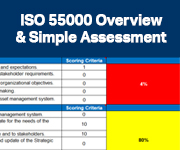Internal Audit for ISO 55000
By Brian Kaiser, Life Cycle Engineering
When looking at the tremendous scale of an asset management implementation, it’s easy to push off some of the “smaller” clauses like 9.2 Internal Audit. In doing so, an organization overlooks a valuable method for gauging project progress and for educating affected personnel about asset management and the ISO standard.
Why should I care about internal audits?
Beyond meeting the letter of the law for ISO 55000 compliance, a properly scoped and targeted internal audit function can be a valuable tool for keeping the organization focused during the asset management journey. For organizations unfamiliar with internal audits, the primary intent is to discover issues and make corrections before an external audit. An internal audit can also serve as a teaching tool that connects business knowledge and experience to the requirements of the standard.
Thus, the internal audit is an effective way to monitor progress while the organization is implementing an asset management system. As major implementation milestones are met, an internal audit should be performed to judge whether the new processes, tools, and systems are adequately meeting the organization’s needs.
To maximize the internal audit’s effectiveness, keep the following principles in mind:
- Scope: The internal audit should include broad audits, to involve every relevant aspect of the organization, and targeted audits, to focus on known gaps and track work to completion.
- Maturity: For an organization new to the concepts of asset management or inexperienced with an internal audit, the interviews should be relaxed, conducted in a friendly environment, and the interviewer should guide the interviewee toward a good answer with evidence.
- Education: Inaccurate answers or insufficient evidence should be answered with guidance on interpretation of the relevant clause(s) and ideas for supporting evidence, delivered in an understanding tone that helps make the internal audit a positive experience for the interviewee.
- Transparency: The internal audit function should report its results clearly and to all parties simultaneously. This helps to quash rumor-spreading and ensures that everyone has the facts at the same time.
After I’ve conducted an internal audit, what’s next?
A productive internal audit results in a list of identified gaps in substance and/or in proper evidence. This list of gaps should then be converted into a roadmap to gap closure with the involvement of the represented departments. Including the relevant people in creating the roadmap creation is critical to gaining buy-in and creating a realistic timeline for closing gaps. Learn about our ISO 55000 Training for Leaders, a one-day virtual workshop.
With tasks implemented for closing the identified gaps from the internal audit, the final step is to gauge the effectiveness of those tasks in closing the gaps. A follow-up audit should focus only on the gap areas and should be scheduled following task implementation and an appropriate monitoring time period (between one to three months). The results of this follow-up audit will indicate which gaps have been closed and which gaps need further work.
Brian Kaiser is an ISO 55000 Subject Matter Expert at Life Cycle Engineering (LCE) with more than 10 years’ professional experience in the electric utility industry. You can reach Brian at bkaiser@LCE.com.

